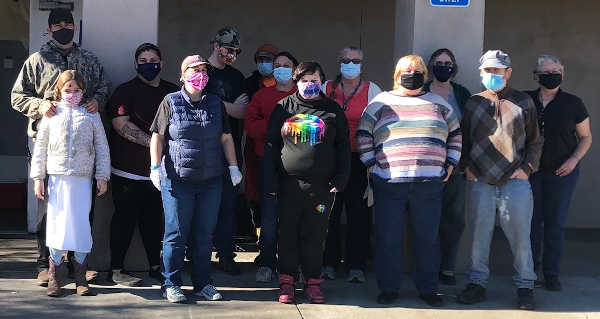Vitalant, the nation’s second-largest community blood service provider, is hosting the 15th Annual Bucket Brigade Blood Drive Challenge.
It’s partnering with 21 fire agencies across Lake, Mendocino and Sonoma counties for this year’s event.
With the COVID-19 pandemic causing major disruptions, Kim Walsh, Vitalant’s donor recruitment representative, said the Bucket Brigade is even more important this year.
Vitalant reported that surges in COVID-19 cases, wildfires, hurricanes and other natural disasters combined with the cancellation of blood drives at schools, businesses and community organizations have brought the blood supply to a critical level on a national level.
Walsh said Vitalant supports 45 Bay Area hospitals.
While they’ve been able to supply those hospitals with what they need, “We’re in need of donors,” Walsh said.
Walsh said they are doing things very differently in response to COVID-19.
“We have had to cancel 2,000 blood drives in the Bay Area,” said Walsh.
On the local level, they’ve also stopped mobile blood drives. Instead, Walsh said they’re looking for spaces of 2,000 square feet and above to allow for social distancing.
She said they are fortunate that the fire stations chose to continue with this year’s Bucket Brigade. “That’s been a huge, huge relief.”
The Bucket Brigade is a friendly competition to see which fire department can host the largest blood drive between December and January.
Vitalant said the Bucket Brigade idea comes from the Great London Fire of 1666 that found community members in “brigades” as they passed buckets of water from the city’s water supply to the blaze that endangered their town and community.
Vitalant Senior Director of Donor Recruitment Andrea Casson brought the participating North Coast fire departments together 15 years ago with the idea of “creating a modern Bucket Brigade that gathers our community in an effort to save lives through blood donations.”
Since 2006, fire departments participating in the Bucket Brigade Challenge have recruited more than 11,000 participants, Vitalant reported.
For Lake, Mendocino and Sonoma counties, Walsh said 80 percent of the mobile blood drives in December have been Bucket Brigade events.
Walsh said Lake County’s participating fire agencies – Lakeport Fire and South Lake County Fire – typically perform very well and are consistently among the top drives in the Bucket Brigade.
Last year, Lakeport had 65 donors and placed fourth out of 21 competitors, while South Lake County came in seventh with 56 donors, Walsh said.
Lakeport Fire’s blood drive won’t take place in the downtown station’s truck bay as in past years. Walsh said this year it will be held in the larger – and heated – Silveira Community Center across N. Main Street.
As a special thank you, blood donors will receive an annual event T-shirt.
To find a drive near you, see the complete list of Bucket Brigade blood drive events published below.
Appointments for the Bucket Brigade are encouraged. Visit www.vitalant.com and use the sponsor code, Middletown or Lakeport, for the Lake County blood drive where you wish to donate.
For your donation, please arrive well-hydrated and well-nourished, with a face mask and photo identification.
Besides the Bucket Brigade, Walsh said Vitalant is in Lake County once a month to collect blood donations.
To make an appointment, get eligibility information and to learn more about how Vitalant is adjusting to the pandemic, visit www.vitalant.org or call 877-258-4825.
15th Annual Bucket Brigade Blood Drive events
Lake County
Saturday, Dec. 5
South Lake County Fire Protection District
10 a.m. to 3 p.m.
Station 60, 21095 State Highway 175, Middletown
Saturday, Dec. 19
Lakeport Fire Protection District
9:30 a.m. to 2 p.m.
Silveira Community Center, 500 N. Main St.
Mendocino County
Tuesday, Dec. 1
Ukiah Valley Fire Authority
1:30 to 5:45 p.m.
Community center, 200 School St., Ukiah
Monday, Dec. 28
Fort Bragg and Mendocino Volunteer Fire Department
1 to 5:30 p.m.
Town Hall, 363 N. Main St., Fort Bragg
Tuesday, Dec. 29
Fort Bragg and Mendocino Volunteer Fire Department
10 a.m. to 2:30 p.m.
Town Hall, 363 N. Main St., Fort Bragg
Wednesday, Jan. 13
Hopland Volunteer Fire Department
1 to 6 p.m.
Fire station, 21 Feliz Creek Road
Sonoma County
Tuesday, Dec. 15
Sebastopol Fire Department
1 to 6 p.m.
Fire station, 7425 Bodega Bay Ave.
Tuesday, Dec. 22
Graton Fire Protection District
1:30 to 6 p.m.
Fire station truck bay, 3750 Highway 116 North
Wednesday, Dec. 30
Forestville Fire Department
2 to 6:30 p.m.
Fire station: 6554 Mirabel Road
Sunday, Jan. 3
Rohnert Park Department of Public Safety
9:30 a.m. to 2:30 p.m.
SOMO Event Center, 1100 Valley House Drive
Wednesday, Jan. 6
Santa Rosa Fire Department
9:30 a.m. to 1:30 p.m.
Training center, 35 Stony Point Road
Saturday, Jan. 9
Healdsburg Fire Department
9:30 a.m. to 2:30 p.m.
Fire station, 601 Healdsburg Ave.
Thursday, Jan. 14
Sonoma County Fire District
1:30 to 6:30 p.m.
Rincon Valley Station Fire Station, 91 Middle Rincon Road, Santa Rosa
Friday, Jan. 15
Cloverdale Fire Protection District
1:30 to 6 p.m.
Fire station, 451 S. Cloverdale Blvd.
Wednesday, Jan. 20
Sonoma Valley Fire District
10 a.m. to 3 p.m.
Vintage House, 264 First St. East, Sonoma
Friday, Jan. 22
Northern Sonoma County Fire Protection District
1:30 to 6:30 p.m.
District fire station, 20975 Geyserville Ave., Geyserville
Monday, Jan. 25
Wilmar and San Antonio Volunteer Fire Departments
1 to 6 p.m.
Wilmar Fire Station, 3825 Bodega Ave., Petaluma
Tuesday, Jan. 26
Petaluma Fire Department and Rancho Adobe Fire District
1 to 6 p.m.
Petaluma Elks Lodge, 2105 S. McDowell Blvd., Petaluma
Wednesday, Jan. 27
Petaluma Fire Department and Rancho Adobe Fire District
10 a.m. to 3 p.m.
Petaluma Elks Lodge, 2105 S. McDowell Blvd., Petaluma
Saturday, Jan. 30
Sonoma County Fire District – Windsor Station
9:30 a.m. to 2:30 p.m.
Huerta Gym, 9291 Old Redwood Hwy #200, Windsor
Email Elizabeth Larson at

 How to resolve AdBlock issue?
How to resolve AdBlock issue? 























